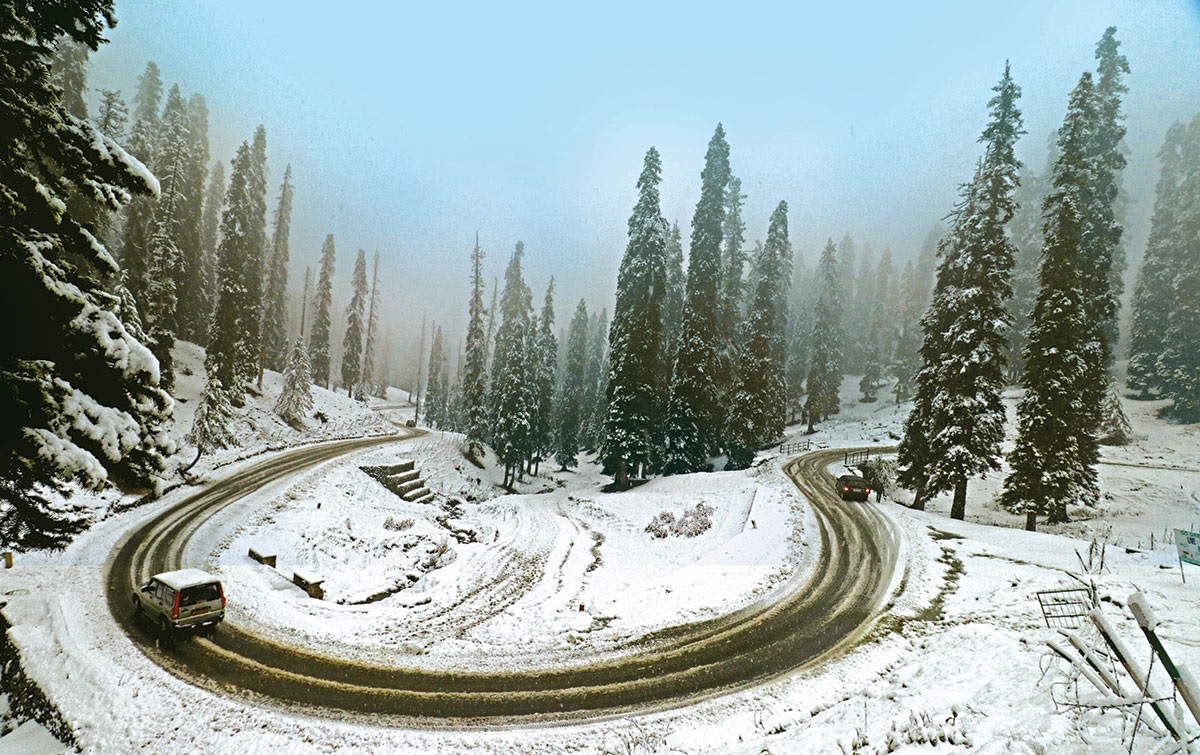Setting legends aside, after British visitors discovered Gulmarg as a leisure spot in Kashmir during the late nineteenth century, it evolved into a year-round destination. It remains just as crowded in winter as it is during the busy summer months, writes M Saleem Beg
Gulmarg, the meadow of flowers nestled in the Pir Panjal range, has emerged as a major round the year tourist destination in the Himalayan Valley of Kashmir. Located at an altitude of 8000 plus feet above sea level, it is encased by snow-peaked alps, verdant green pastures, colourful meadows, deep valleys, and pine-covered slopes.
The margs, a continuous series along the mountain slopes, are a unique geographic feature of Pir Panjal. At an elevation of above 7000 ft above seal level, these open lands do not have the tree cover found in the surrounding hill slopes bordering these meadows. These are stretches of uplands generally occupying a depression between the tree-covered slopes and ridges of the foothills. They must have, in earlier times, been glacier-filled, as even now the snow accumulates and stays in their broad hollow spaces.

Myths and Legends
The succession of margs all along the Pir Panjal have hosted most exciting expeditions in Kashmir in the past. Camping day after day in these grassy meadows has been a dream sojourn for the Europeans, to whom we also owe the popularity of these exquisite locales.
There are legends, locally circulated as historical facts, not always authenticated, that refer to the popularity of the Gulmarg during the medieval period as also purported visits of the kings including Mughal kings.
The first published material on the natural landscapes of Kashmir is from Bernier (1630-68 AD), who was part of the entourage of Mughal King Aurangzeb. He does not mention Gulmarg, though his writings show his great attention to detail. An excerpt reproduced here: “Kashmir is graced and protected by the successive emperors of Delhi. The suburbs of Srinagar are very attractive, crowded with houses and flower gardens. The lake has several islands and pleasure grounds, which look beautiful and green in the midst of water. The whole kingdom wears the appearance of a fertile and highly cultivated garden”.
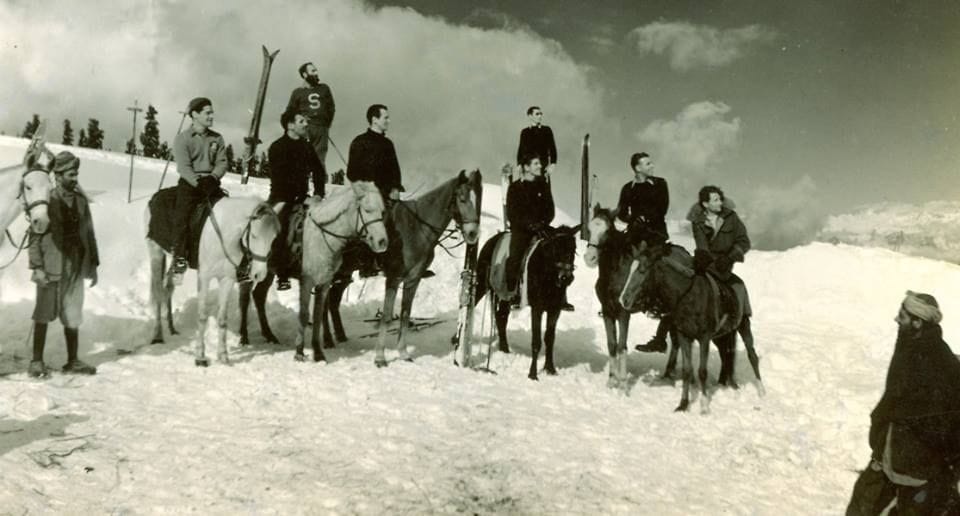
It was not only the natural beauty of the country that attracted Bernier; he was attracted to the people too. “The Kachemirys are celebrated for their wit and are much more intelligent and ingenious than the Indians. In poetry and the sciences, they are not inferior to Iranians”. The Mughal Kings’ visit to Gulmarg would have, in all probability been mentioned in his memoirs if it had taken place.
The Discovery
Gulmarg was for the first time brought on the travel map of the world by a British geologist and topographer, Godwin Austen, in 1860 as a summer hill station. Subsequently, the British made a beeline towards Gulmarg, longing for ‘Scotland’s glens and seeking relief from the sweltering heat of the Indian plains’.
The rather prolonged stay of the British tourists at Gulmarg gave rise to a community that shaped into a habitation with all its interesting shades. A little later, it became the favourite health resort of British residents, British missionaries, and foreign travellers, all during the late nineteenth century. Also aptly called the resort of the Raj, its charms attracted the local rulers and their cohorts, who were somewhat segregated for reasons of cultural differences as well as the highbrow attitude of the foreign visitors towards the desi’s. The British Resident retained his pomp by providing for a lifestyle appropriate for a master who retained suzerainty over the Riyasat.
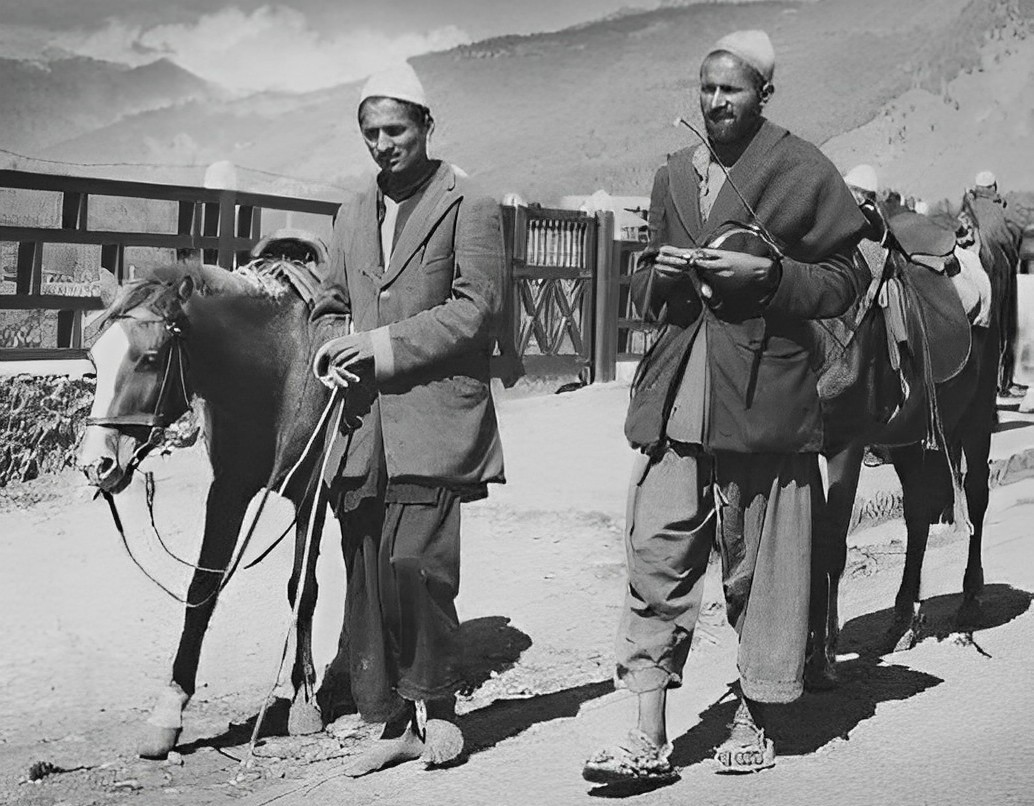
Brigid Kenaan, the author of Travels in Kashmir: A Popular History of Its People, Places, and Crafts, quotes one Miss Morrison who maintained a diary of her stay in Gulmarg during first decade of twentieth century that was later published as a book: ‘Gulmarg is a pleasant little place where one could get to know almost everybody and feel at home. Gulmarg was full of military men on leave from lonely, outlying districts of India, who were determined to enjoy their precious few weeks of freedom, and there was no dearth of men for picnics and no lack of partners at the dances held in the Nedoes hotel nor at dinner at private parties. In those days, the road from Srinagar to Gulmarg stopped three miles short of the resort at Tangmarg. Here, the mountain became too steep for wheeled vehicles, and visitors had to complete their journey on foot or on ponies. An hour’s toiling up the woodland path brought us to the entrance of Gulmarg’.
Ms Morrison, in what is probably the liveliest description of the place more than a century back writes that: “On the right, stands the Residency; on the left, the doctor’s house; straight in front are the grassy plains of Gulmarg bearing signs of civilisation on their two or more miles of undulating greenness. Most conspicuous is the Maharaja’s palace, bare and ugly as a barrack; opposite to it, on a knoll, stands the little English church; eager golf players can be seen following the winding course of the links from green to green; a polo ground; and a club house. Tennis and badminton courts occupy a central position accessible to all; further on are the hotel buildings standing on a spur of land, all roughly built wooden houses barely more than huts but still command a very fancy price during the season.
Set With Pearls
Another book that offers more details is Emerald Set With Pearls by Florence Parbury, a British visitor who visited Kashmir in 1902 and published the book in 1909. She writes, “It was a paradise of flowers. We felt so in touch with nature that we took out our guitars and sang our old songs”.
There are books, fiction, and daily diaries that speak of jealousies, scandals, and unfulfilled romances woven around this little community of British men and women that help to know the gay and lively atmosphere in their small and short-lived world. By this time, Gulmarg also had one of the best-stocked stores, like W Lamberts, the famous Mahhattas, photographers, and a large summer market of Kashmir Arts, selling leather, shawls, papier mâché, and the like.
By the end of August, Miss Morrison and others of her ilk knew they must leave Gulmarg and press on to accomplish a trek up the Sind valley.
This summer holiday resort was waiting for the British leisure and sports infrastructure, and that is how a golf course and a golf club got in. While a six hole course was built in 1890 by golf enthusiasts from the British Army, a club house with attendant facilities came up around 1911.
Skiing Is Recent
We do not have much evidence about skiing until 1960, when Rudolph Matt, an alpine skier and world skiing champion in 1960, chanced on Gulmarg and chose it as a winter skiing resort. There was no looking back after his arrival and the place became a much sought-after winter sports and tourist destination. While it has picturesque beauty, Gulmarg is known for its ski infrastructure. Outside Alps, it is perhaps the only spot where we have skiing worthy powder-snow.

Established in 1987, the Gulmarg Gondola is Asia’s second-longest cable car ride and the highest golf course in the world at an elevated altitude of 2650 meters. The gandola was built in two phases as a collaborative project between Jammu and Kashmir Government and Polmagaski, the French pioneering ski infa company.
Gulmarg is an absolute delight for nature lovers and adventure seekers. Called the ‘heartland of winter sports’, it offers a plethora of activities such as skiing, snowboarding, horse-riding, heli-skiing, snow scootering, tobogganing, etc. and sightseeing options. Thus, Gulmarg became a year-round destination and the first winter destination in the country.
Focussed Attention
Gulmarg has had the privilege of receiving focused attention, especially after 1975, when Sheikh Mohammad Abdullah took over the reins of power in the state. He had an intimate relationship with the place; his wife’s family had huge properties there that included its first hotel, the Nedoes. His family has couple of properties, both commercial and residential in Tangmarg and Gulmarg.
Some time in 1978 a high powered official agency, Gulmarg Project Organisation was set up that was converted subsequently into Gulmarg Development Authority in 2003. Besides providing much-needed civic infrastructure, a master plan that factored in sustainability and ecological sensitivity was put in place.
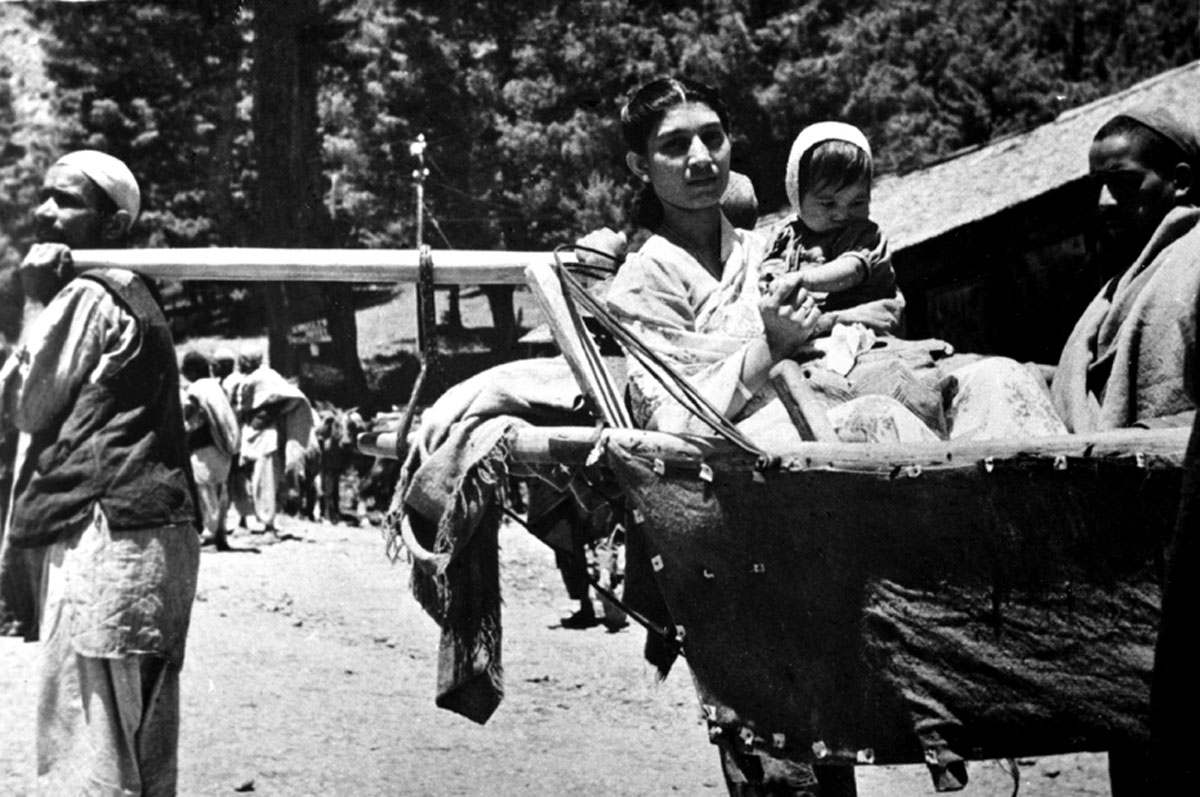
In the first of its actions, the vastly encroached bowl, the present golf course, was cleared from the ugly and inappropriate structures. In recent years, Gulmarg has attracted investments in the tourist accommodation sector, including the best and the priciest boutique hotel, the Khyber Resorts.
The Highland Park Hotel, one of the oldest and, for long, the abode of high-end visitors, retains its old-world charm. With the constant upgrade of the facilities, Highland is still the best address in the resort.
Sustainability
Looking at the sustainability of the resort, one of the policy papers mentions that ‘the ideal idea for the development of Gulmarg is to leave it alone as virgin as possible, focusing on good road connectivity, cleanliness, and sanitation necessitated by the huge tourist inflow, which undoubtedly has always been much beyond the carrying capacity of the destination and proper solid waste disposal’. But then regulating the flow of visitors within sustainable limits would not be possible for any management, as post the 1990s, the tourist inflow has almost always been related to the peace index of the valley.
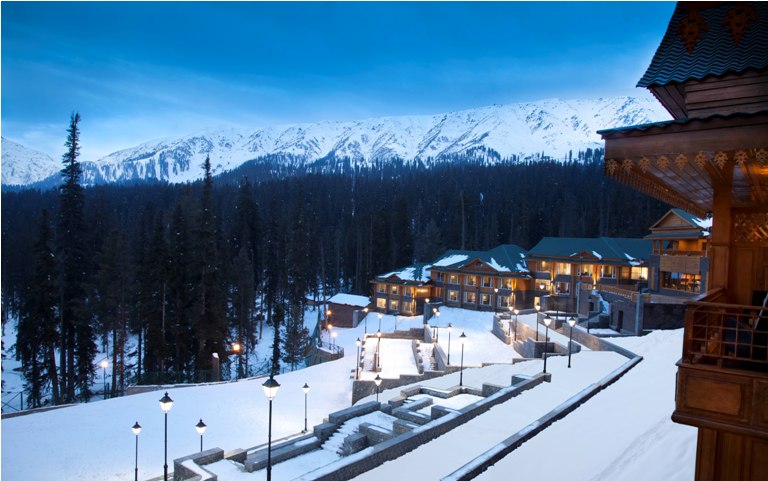
Successive governments have, as a matter of policy, encouraged the development of tourism infrastructure at important tourist destinations, including Gulmarg. In order to reduce pressure on the main bowl, efforts to expand tourism activities beyond the bowl became one of the main concerns. This resulted in more focus on the lake area, Leopard, Strawberry Valley, and far beyond Botapathri, Nagin areas in Gulmarg, and Drang and Baba Reshi near Tangmarg.
The above quote flags the issues but leaves them to their own destiny.
Increased Footfalls
The destination is already under huge stress due to excessive footfalls, construction activities, and the loss of biodiversity and forest cover. Over and above, the most critical and hugely disastrous impact of the recent amendment in the Forest Conservation Act by the Parliament is looming large. It exempts certain types of land from the purview of the Act. These include land within 100 km of India’s border needed for national security projects, small roadside amenities, and public roads leading to habitation.
Allowing diversion of forest land for construction of security-related projects and within 100 km of the international border/LOC/LAC will hasten the decline in forest cover in these areas. The 100 km distance from international borders would cover most of the Himalayan states. In Jammu and Kashmir, 100 km from the LOC/LAC will remove protection for forests altogether, except maybe the Kishtwar belt bordering Himachal Pradesh, unless that gets covered by the LOC in Kargil.
This exemption will also remove protection to other Himalayan states like Sikkim, with 47 per cent forest cover, and Uttarakhand, with 45 per cent forest cover. Kashmir has a forest cover of 50.97 per cent and Jammu 45.89 per cent. Along with this the fate of 185 Sq Km Gulmarg Wildlife sanctuary notified by Government of India in 1987 hangs in balance with loss of protection of the buffer of the notified forest.

The whole of the LoC is under the control of Army as that is the strategic requirement of protecting the country’s borders. This runs as deep as 10 kms inside our borders. The Defence establishment in the Gulmarg tourism bowl is in possession of 300 acres of land out of which 138 acres has been formalised by the erstwhile State Government. With the recent amendment, we need to watch how it unfolds and how Gulmarg faces this huge challenge.
(Currently heading the INTACH Kashmir chapter, the author has served as Director General of Tourism in Jammu and Kashmir. Ideas are personal.)





